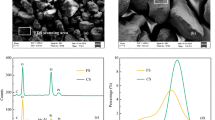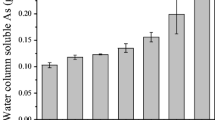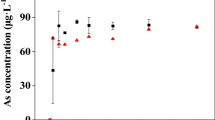Abstract
Elevated concentrations of arsenic in the sediment and pore water in the Sundarban wetlands pose an environmental risk. Adsorption and desorption are hypothesized to be the major processes controlling arsenic retention in surface sediment under oxic/suboxic condition. This study aims to investigate sorption kinetics of As(III & V) and its feedback to arsenic mobilization in the mangrove sediment. It ranges from sand to silty clay loam and shows the adsorption of As(III & V) following the Langmuir relation. Estimates of the maximum adsorption capacity are 59.11 ± 13.26 μg g−1 for As(III) and 58.45 ± 8.75 μg g−1 at 30°C for As(V) in the pH range 4 to 8 and salinity 15–30 psu. Extent of adsorption decreases with increasing pH from 4 to 8 and desorption is the rate-limiting step in the reaction of arsenic with sediment. Arsenic in the sediment could be from a Himalayan supply and co-deposited organic matter drives its release from the sediment. Arsenic concentration in the sediment is well below its maximum absorption capacity, suggesting the release of sorbed arsenic in pore water by the microbial oxidation of organic matter in the sediment with less feedback of adsorption.






Similar content being viewed by others
References
Acharya SK, Lahiri S, Kaymahashay BC, Bhowmic A (2000) Arsenic toxicity in ground water in parts of Bengal Basin in India and Bangladesh: role of quaternary stratigraphy and Holocene sea-level fluctuation. Environ Geol 39(10):1127–1137
Arthur DL (1984) Full-scale field evaluation of waste disposal from coal-fired electric generating plants, Final Report to US EPA. Office of Research and Development, Washington, Appendix F (Part 4), EPA contract no. 68-02-3167
Barman RS, Johnson DL, Foreback CC, Ammous JM, Bricker JL (1977) Separation and determination of nanogram amount of inorganic arsenic and metal arsenic compounds. Anal Chem 49(4):621–625
Banerjee K, Senthilkumar B, Purvaja R, Ramesh R (2011) Sedimentation and trace metal distribution in selected locations of Sundarbans mangroves and Hooghly estuary, northeast coast of India. Environ Geochem Health. doi:10.1007/s10653-011-9388-0
Bolan NS, Syers JK, Tillman RW (1986) Ionic strength effects on surface charge and adsorption of phosphate and sulphate by soils. Eur J Soil Sci 37:379–388
Bowell RJ (1994) Sorption of arsenic by iron oxides and oxyhydroxides in soils. Appl Geochem 9:279–286
Buschmann J, Berg M (2009) Impact of sulfate reduction on the scale of arsenic contamination in groundwater of the Mekong, Bengal and Red River Deltas. Appl Geochem 24(7):1278–1286
Canuel EA, Martens CS (1993) Seasonal variability in the sources and alteration of organic matter associated with recently deposited sediments. Org Geochem 20(5):563–577
Culkin F, Cox RA (1966) Sodium potassium, magnesium, calcium and stroncium in sea water. Deep Sea Res 13:785–789
Das D, Samanta G, Mondal BK, Chowdhury RT, Chanda CR, Chowdhury PP, Basu GK, Chakrabarty D (1996) Arsenic in ground water in six districts of West Bengal, India. Environ Geochem Health 18:5–15
Dzombak DA, Morel FMM (1990) Surface complexation modeling: hydrous ferric oxide. Wiley, New York
Fuller CC, Davis JA, Waychunas GA (1993) Surface chemistry of ferrihydrite: part 2. Kinetics of arsenate adsorption and coprecipitation. Geochim Cosmochim Acta 57:2271–2282
Gao S, Goldberg S, Herbel MJ, Chalmers AT, Fujii R, Tanji KK (2006) Sorption processes affecting arsenic solubility in oxidized surface sediments from Tulaure Lake Bed, California. Chem Geol 228:33–43
Ghatak H, Mukhopadhyay SK, Biswas H, Sen S, Jana TK (2002) Quantitative study of CO (III) complexation by synchronous fluorescence spectroscopy with Sundarban mangrove habitat humic substances. Indian J Mar Sci 31(2):136–140
Goldberg S (2002) Competitive adsorption of arsenate and arsenite on oxides and clay minerals. Soil Sci Soc Am J 66:413–421
Goodbred SL Jr, Kuehl SA (2000) The significance of large sediment supply, active tectonism, and eustasy on margin sequence development: late quaternary stratigraphy and evolution of the Ganges–Brahmaputra delta. Sediment Geol 133:227–248
Grasshoff K, Ehrhardt M, Kremling K (1983) Methods of seawater analysis, 2nd edn. Verlag Chemic, Germany
Grossl PR, Eick M, Sparks DL, Goldberg S, Ainsworth CC (1997) Arsenate and chromate retention mechanisms on goethite. 2. Kinetic evaluation using a pressure–jump relaxation technique. Environ Sci Technol 31:321–326
Hering JG, Kneebone PE (2002) Biogeochemical controls on arsenic occurrence and mobility in water supplies. In: Frankenberger WT Jr (ed) Environmental chemistry of Arsenic. Marcel Dekker, New York, p 161
Jones CA, Langner HW, Anderson K, McDermott TR, Inskeep WP (2000) Rates of microbially mediated arsenate reduction and solubilization. Soil Sci Soc Am J 64:600–608
Kirk MF, Holm TR, Park J, Jin Q, Sanford RA, Fouke BW, Bethke CM (2004) Bacterial sulfate reduction limits natural arsenic contamination in groundwater. Geol 32(11):953–956. doi:10.1130/G20842.1
Kumar SR (1996) Distribution of organic carbon in the sediments of Cochin mangroves, southwest coast of India. Indian J Mar Sci 25:274–276
Langmuir D, Mahoney J, Rowson J (2006) Solubility products of amorphous ferric arsenate and crystalline scorodite (FeAsO4.2H2O) and their application to arsenic behavior in buried mine tailings. Geochim Cosmochim Acta 70:2942–2956
Lee SZ, Allen HE, Huang CP, Sparks DL, Sanders PF, Peijnenburg WJGM (1996) Predicting soil–water partition coefficients for cadmium. Environ Sci Technol 30(12):3418–3424
Loring DH, Rantala RTT (1992) Manual for geochemical analysis of marine sediment and suspended particulate matter. Earth Sci Rev 32:235–283
Lowers HA, Breit GN, Foster AL, Whitney J, Yount J, Uddin MdN, Muneem A (2007) Arsenic incorporation into authigenic pyrite, Bengal Basin sediment, Bangladesh. Geochim Cosmochim Acta 71:2699–2717
Lu Y, Pignatello JJ (2002) Demonstration of the “conditioning effect” in soil organic matter in support of a pore deformation mechanism for sorption hysteresis. Environ Sci Technol 36:4553–4561
Manceau A (1995) The mechanism of anion adsorption on iron oxides: evidence for the bonding of arsenate tetrahedra on free Fe (O, OH)6 edges. Geochim Cosmochim Acta 59(17):3647–3653
Mandal SK, Dey M, Ganguly D, Sen S, Jana TK (2009) Biogeochemical controls of arsenic occurrence and mobility in the Indian Sundarban mangrove ecosystem. Mar Pollut Bull 58(5):652–657. doi:10.1016/j.marpolbul.2009.01.010
Meharg AA, Scrimgeour C, Hossain SA, Fuller K, Cruickshank K, Williams PN, Kinniburgh DG (2006) Codeposition of organic carbon and arsenic in Bengal Delta aquifers. Environ Sci Technol 40(16):4928–4935
Mertal J, Charlet L, Burean S, Mallik SB, Chakraborty S, Ahmed KM, Rahman MW, Cheng Z, Vangeen A (2008) Comparison of dissolved and particulate arsenic distribution in shallow aquifers of Chakdaha, India and Araihazar, Bangladesh. Geochem Trans 9:1. doi:10.1186/1467-4866-9-1
Mott CJB (1981) Anion and ligand exchange. In: Green DJ, Hays MHB (eds) The Chemistry of soil processes. Wiley Interscience, New York
National Institute of Standards and Technology (2003) Critically selected stability constants of metal complexes database. version 7.0. U.S. Department of Commerce, Gainsburg
Pan G, Liss PS, Krom MD (1999) Particle concentration effect and adsorption reversibility. Colloids Surf A Physicochem Eng Asp 151:127–133
Parfitt RL, Atkinson RJ, Smart RSC (1975) The mechanism of phosphate fixation by iron oxides. Soil Sci Soc Am Proc 39:837–841
Ray R, Ganguly D, Chowdhury C, Dey M, Das S, Dutta MK, Mandal SK, Majumdar N, De TK, Mukhopadhyay SK, Jana TK (2011) Carbon sequestration and annual increase of carbon stock in a mangrove forest. Atmos. Env. doi:10.1016/j.atmosenv.2011.04.074
Sarkar SK, Franciskovic-Bilinski S, Bhattacharya AK, Saha M, Bilinski H (2004) Levels of elements in the surficial estuarine sediments of the Hugli River, northeast India and their environmental implications. Environ Int 30:1089–1098
Shrawat KL (1982) Simple modification of the Walkley–Black method for simultaneous determination of organic carbon and potentially mineralizable nitrogen in tropical rice soils. Plant Sci 69:73–77
Siegel M, Aragon A, Zhao H, Deng S, Nocon M, Aragon M (2008) Prediction of arsenic removal by adsorptive media. In: Comparison of field and laboratory studies in arsenic contamination of groundwater. John Wiley & Sons, Inc.227
Silva Filho EV, Jonathan MP. Chatterjee M, Sarkar SK, Sella SM, Bhattacharya A, Satpathy KK (2010) Ecological consideration of trace element contamination in sediment cores from Sundarban Wetland, India, Environ Earth Sci. doi:10.1007/s 12665-010-079S-9
Sims JT, Heckendorn SE (1991) Methods of analysis of the university of delaware soil testing laboratory. Cooperative bulletin no. 10, University of Delaware, Newark
Sposito G (1984) The surface chemistry of soils. Oxford University Press, New York
Villapando RR, Graetz DA (2001) Phosphorus sorption and desorption properties of the spodic horizon from selected Florida Spodosols. Soil Sci Soc Am J 65:331–339
Vischer PT, Beukema J, van Gemerden H (1991) In situ characterization of sediments: measurements of oxygen and sulfide profiles with a novel combined needle electrode. Limnol Oceanogr 36:1476–1480
Wagemann R (1978) Some theoretical aspects of stability and solubility of inorganic arsenic in the fresh water environment. Water Res 12:139–145
Wauchope RD, McDowell LL (1984) Adsorption of phosphate, arsenate, methanearsonate and cacodylate by lake and stream sediments: comparisons with soils. J Environ Qual 13:499–504
Webster JG (1990) The solubility of As2S3 and speciation of As in dilute and sulphide bearing fluids at 25 and 90° C. Geochim Cosmochim Acta 54(4):1009–1017
Wu J, Laird DW, Thompson ML (1999) Sorption and desorption of copper on soil clay components. J Environ Qual 28:334–338
Xu HB, Allard B, Grimvall A (1988) Influence of pH and organic substance on the adsorption of As(V) on geologic materials. Water Air Soil Pollut 40:293–305
Yamamoto M, Yasuda M, Yamamoto Y (1985) Hydride generation atomic absorption spectroscopy coupled with flow injection analysis. Anal Chem 57:1375–1382
Zobrist J, Dowdle PR, Davis JA, Oremland RS (2000) Mobilization of arsenite by dissimilatory reduction of adsorbed arsenate. Environ Sci Technol 34:4747–4753
Acknowledgments
One of the authors (N.M.) is grateful to UGC, New Delhi for providing fellowship. Thanks are also due to the Sundarban Biosphere Reserve and Divisional Forest Office, Govt. of West Bengal, for giving permission to carry out the experiments. We are grateful to the peer reviewers for their helpful and constructive suggestions.
Author information
Authors and Affiliations
Corresponding author
Rights and permissions
About this article
Cite this article
Mandal, S.K., Majumder, N., Chowdhury, C. et al. Adsorption kinetic control of As(III & V) mobilization and sequestration by Mangrove sediment. Environ Earth Sci 65, 2027–2036 (2012). https://doi.org/10.1007/s12665-011-1183-9
Received:
Accepted:
Published:
Issue Date:
DOI: https://doi.org/10.1007/s12665-011-1183-9




